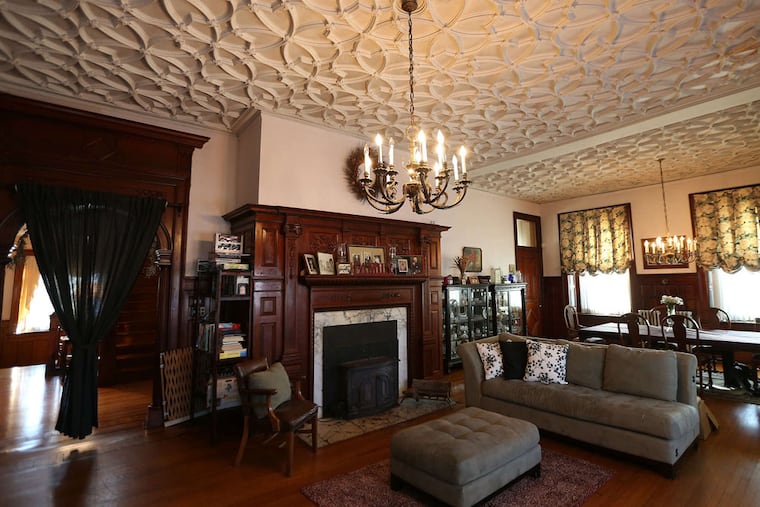Haven: On G Street, an architectural gem
Old-timers who grew up near the legendary intersection of Kensington and Allegheny still refer to the architectural gem on G Street as "the Mansion."

Old-timers who grew up near the legendary intersection of Kensington and Allegheny still refer to the architectural gem on G Street as "the Mansion."
Indeed, the splendid fieldstone structure, which towers above red-brick rowhouses, was the grandest private home in Philadelphia's Kensington section when it was built more than a century ago.
For the last 40 years, it's been the residence of Betty Ann Guckin, as well as the epicenter of Guckin Funeral Mansion, the family business she maintains.
"I can't imagine living anywhere else," says Guckin, 45, partly about her home, and partly about the surrounding neighborhood, where she has spent her entire life.
During its heyday, K&A was a bustling blue-collar district, where generations of breadwinners toiled in textile mills and meat-distribution centers. Over time, industries pulled out, leaving Kensington a gritty facsimile of its earlier self. Today, abandoned factories, shuttered churches, and hollowed-out houses wait patiently, hoping that gentrification will save them.
In 1907, Irish immigrant Michael O'Rourke, who was a municipal contractor, spent $106,000 to build the 15-room mansion and three outbuildings. After his death, businessman Conrad Campbell owned it from 1914 until 1970. Ascension of Our Lord parish owned it for four years afterward.
By the time Andrew "Andy" Guckin, Betty Ann's father, thought about buying the mansion in 1974, it was in disrepair.
"Each of the 81 windowpanes was broken," she says.
Still, there was no question that the four-story building was worth preserving. Andy Guckin, who had a funeral home in a rowhouse a few blocks away, saw something majestic about the building's bones, not just as a residence for him and his wife, Erna, to raise their three young daughters, but also as an elegant bastion for his business.
Entering the mansion reminds one of bygone days, when people wore white gloves.
"It was so much fun growing up here," recalls Betty Ann. "My friends would come over, and we had this huge building to play in and investigate."
Among its original assets are sweeping staircases, elaborate interior woodwork, eight fireplaces, and ornate stained-glass windows and transoms. Other artifacts include the servants' call box, antique chandeliers, and two vintage bread warmers.
O'Rourke built six spacious bathrooms - perhaps due to the notion that multiple bathrooms signified prosperity in the early 20th century. Each bath still possesses original fixtures, subway tiles, and soaking tubs.
After Andy, 85, whose own childhood roots are embedded in Kensington, acquired the property, he hired local tradesmen to refinish the hardwood flooring, update the electricity and plumbing, and restore the slate roof, stone exterior, and plaster ceilings.
The first floor was reconfigured into parlors, which tend to be always arranged with rows of padded chairs in preparation for future funerals, appearing both utilitarian and remote.
Against the walls, Betty Ann points out two church pews from now-closed Ascension of Our Lord, where she attended elementary school.
"I cherish these pieces. I heard they were selling them, and I went right over and bought them for $25 each."
The second floor was redesigned to be the main living quarters, but the plaster ceilings and the 6-foot double-hung windows were left intact.
There are three bedrooms and an open-profile living/dining room, where family celebrations for 20 can be held around an 80-year-old dining table that belonged to Betty Ann's grandparents. The few modern pieces include a flat-screen TV, a sofa, guitars, and game systems belonging to Betty Ann's son, 9-year-old Andrew Guckin II.
The one room that's been swept into this millennium is the kitchen, with a copper-hued tin backsplash, a large butcher-block island, a slate floor, and sleek appliances.
Betty Ann says the third and fourth floors were once servants' quarters, and would also be occupied by guests traveling from Ireland to visit the mansion dwellers. These days, she uses them for storage.
"You have to see this," she says: Beyond the black-topped rowhouse roofs can be seen exquisite views of the Center City skyline and the Benjamin Franklin Bridge.
Across the driveway, the one-bedroom caretaker's carriage has been remodeled into a grieving center. The stable-turned-carport accommodates hearses; the hay barn is used for storage.
Occasionally, Betty Ann says, she runs into people surprised she still lives in the mansion and has stayed in Kensington.
"The neighborhood isn't the same as when I grew up. But the people here are good people. And I know they appreciate the service I give them."